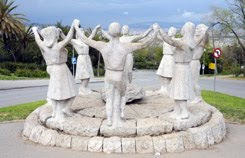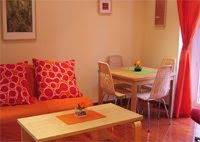Barcelona is a testament to the work and art of famed architect Gaudi. He is not only one of Spain's most famous architects, but one of Europe's most famous. The city of Barcelona is famed for his  designs and if you visit the city, here are 3 of the best sights to see.
designs and if you visit the city, here are 3 of the best sights to see.
1. La Sagrada Familia - This famous temple is Barcelona's most famous attraction, not only because it is arguably Gaudi's best creation, but because it has taken so long to build. La Sagrada Familia first began construction in 1882, but due to delays, finances and resources the building still will not be finished for at least another 90 years. While its distinctive design makes it easy to spot in Barcelona, La Sagrada Familia split opinion when it was first announced. Today, it is incredibly popular with the tourists and has to be seen to be truly believed.
2. La Pedrera - Formerly known as Casa Mila, La Pedrera is a stunningly design block of flats that is famed throughout Spain for its 'wavy' design, coloured materials and the 'Virgin' statue atop it. The flats were originally built for the Mila family, but the building was partially destroyed by the Spanish government. If you are visiting the city during the summer, then you will be able to go on to the building's roof and enjoy a glass of wine while looking out over the city. This La Pedrera de Nit' is highly recommended and one of the attractions for Barcelona art and culture. 3. Park Guell - One of Barcelona's main parks, the Park Guell is filled with Gaudi's creations, chief among them is a massive coloured lizard. Due to its bizarre nature and location, it is incredibly popular with tourists, as is the park itself as it was Gaudi's home for the last two decades of his life.
 designs and if you visit the city, here are 3 of the best sights to see.
designs and if you visit the city, here are 3 of the best sights to see. 1. La Sagrada Familia - This famous temple is Barcelona's most famous attraction, not only because it is arguably Gaudi's best creation, but because it has taken so long to build. La Sagrada Familia first began construction in 1882, but due to delays, finances and resources the building still will not be finished for at least another 90 years. While its distinctive design makes it easy to spot in Barcelona, La Sagrada Familia split opinion when it was first announced. Today, it is incredibly popular with the tourists and has to be seen to be truly believed.
2. La Pedrera - Formerly known as Casa Mila, La Pedrera is a stunningly design block of flats that is famed throughout Spain for its 'wavy' design, coloured materials and the 'Virgin' statue atop it. The flats were originally built for the Mila family, but the building was partially destroyed by the Spanish government. If you are visiting the city during the summer, then you will be able to go on to the building's roof and enjoy a glass of wine while looking out over the city. This La Pedrera de Nit' is highly recommended and one of the attractions for Barcelona art and culture. 3. Park Guell - One of Barcelona's main parks, the Park Guell is filled with Gaudi's creations, chief among them is a massive coloured lizard. Due to its bizarre nature and location, it is incredibly popular with tourists, as is the park itself as it was Gaudi's home for the last two decades of his life.











